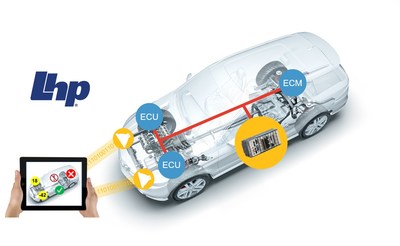

COLUMBUS, Ind., May 16, 2018 /PRNewswire/ -- LHP Engineering Solutions, an engineering services provider and technology integrator has brought together National Instruments, PTC, and AASA's LiFi subsidiary, 01LightComm, to create a framework for an NI-Based Functional Safety and Cyber Security Validation Platform. The demonstration addresses the universal automotive principles of Functional Safety violations resulting from Cyber Security compromises. The impactful automotive demonstration leverages the existing technology available in today's market, introduces LiFi as a viable V2X communication option, and addresses the specific automotive Functional Safety risks in a Cyber Security realm.

What is On-Vehicle Cyber Security
As vehicles are advancing to include autonomy and connectivity, the number of electronic control units and overall complexity is increasing. Thus, on-vehicle Cyber Security violations are becoming a more challenging threat for engineers. Today, a new vehicle can include over 100 million lines of code to monitor everything from ADAS, infotainment systems, blind spot detection, collision avoidance, and vehicle management. The increased complexity poses a greater Cyber Security threat that needs to be addressed immediately. The National Highway Traffic Safety Administration defines Cyber Security within the context of road vehicles as "the protection of automotive electronic systems, communication networks, control algorithms, software, users, and underlying data from malicious attacks, damage, unauthorized access, or manipulation." In terms of today's motorists, manipulation can come in the form of a hacker disabling vehicle communications, disrupting navigation, or interfering with powertrain controls.
LHP Demonstration in NI Automotive-Pavilion
The demonstration will be introduced at the 2018 National Instruments Conference, NIWeek, in Austin, Texas from May 21 – May 24.
What are we demonstrating at NIWeek 2018
The Cyber Security platform leverages the National Instruments CompactRIO to:
The Platform Leverages National Instruments LabVIEW to:
Augmented Reality and LIFI Technology Powered by PTC and AASA Incorporated
Heads-up and augmented reality visualization, driven by the CompactRIO, to automotive testing process is powered by AASA incorporated and PTC ThingWorx.
The Braking, Steering, Functional Safety, and Cyber Security information from the CompactRIO is sent to the Visible Light Communication (VLC) driver of the car headlight. The driver modulates the light to transmit data, which is then received by the mobile device. The augmented reality app on the device displays the received information from different light sources simultaneously. Transmission of data must avoid unwanted sources of light (disturbance) and unauthenticated sources (based on resource access control).
LHP's commitment to growth
Managing Cyber Security risk within vehicles is an ongoing effort for OEM's and technology leaders as the embedded controls of the vehicle continue to advance in complexity. As a member of the Industrial Internet Consortium (IIC), LHP is dedicated to playing an active role in the acceleration of development, adoption, and widespread use of interconnected machines and devices through intelligent analytics. LHP's goal is to drive and develop the framework necessary for a more connected and safer autonomous future.
LHP and our technology partners are dedicated to ensuring quality across the entire development process including R&D, regulation and compliance, architecture build, and software development. Our mission is to create a safer, smarter, and more connected world by specializing in creating custom, flexible, and comprehensive technology solutions in the automotive space.
Learn more about LHP Engineering Solutions by visiting www.lhpes.com.
SOURCE LHP Engineering Solutions